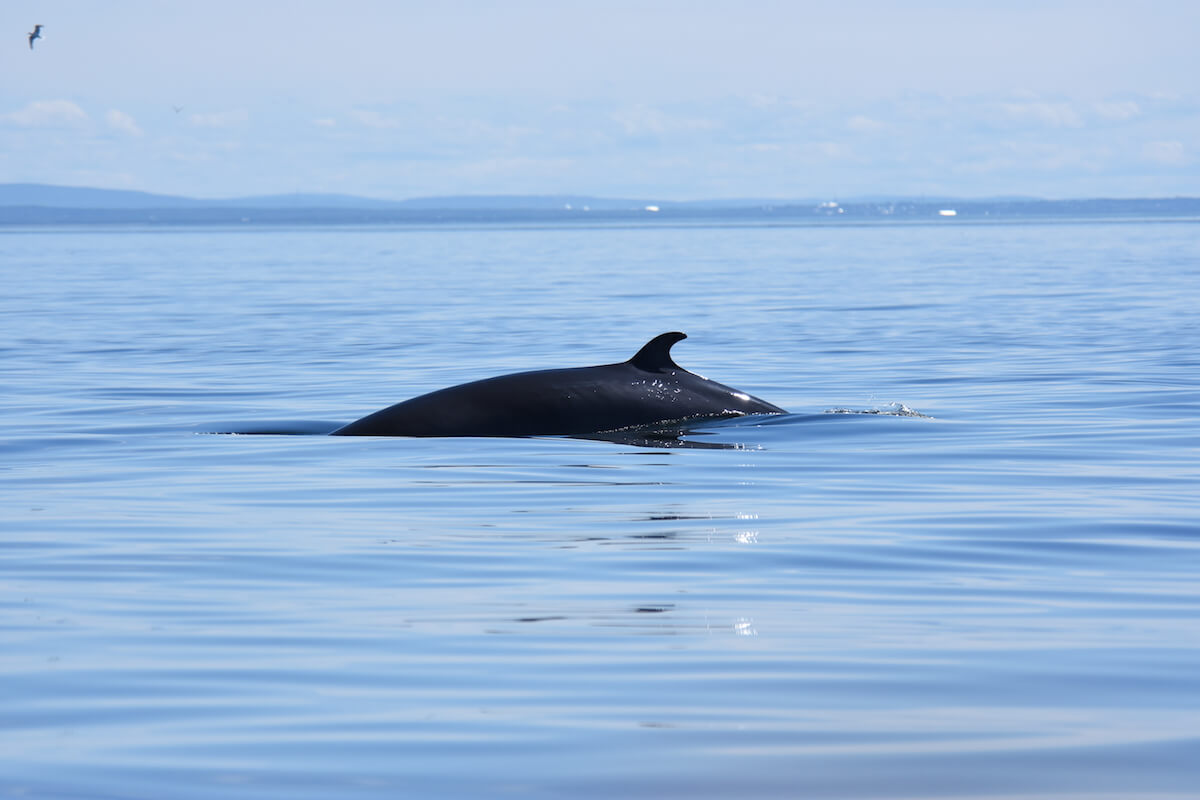Every spring in late March or early April, the smallest of the rorquals is usually the first of the seasonal visitors to arrive in the St. Lawrence for the summer. Observers are therefore eager to witness this migratory animal arrive. This year, the first observation comes from Les Bergeronnes.
For several weeks now, Renaud Pintiaux has been posting on the rocks of Les Bergeronnes in the hope of spotting this dynamic little whale appear offshore. On April 2, he thought he saw one through his binoculars, but the distance made him second guess himself. Four days later, however, there’s no more doubt in his mind. The crescent-shaped back of a minke whale pierces the surface.
Measuring 6 to 10 metres long, minke whales show their blowhole and dorsal fin at the same time. The spout of this species is barely visible. On the other hand, in calm weather, its exhalation is quite loud! The minke whales that visit us are quite solitary and feed by themselves.
On April 7, GREMM’s scientific director Robert Michaud saw a minke whale on two occasions through the window of his home in Les Bergeronnes.
Off the coast of Sept-Îles, Jacques Gélineau is attempting a trip out to sea. He crosses paths with a harp seal, but especially that of a minke whale, his first of the season! Even a northern gannet is spotted flying overhead. Spring migrants are arriving!
What motivates whales to travel so many kilometres up this sort of marine cul-de-sac that the St. Lawrence represents? Food! Each species has its own menu and its own hunting techniques. The blue whale is a specialist: it feeds exclusively on krill. The minke whale will alternate between krill and small schooling fish, depending on prey availability and where it is. Among its favourite fish is capelin, which is also popular with belugas.
In Saint-Irénée, capelin are approaching the coast. This is probably what is drawing a herd of belugas to Anse-au-Sac. “I’m delighted to see them again. I counted up to 12 at one time,” exclaims one resident.
In Les Escoumins, an observer witnesses an active hunting foray involving about fifteen seals at the mouth of the Petits-Escoumins River. The seals dive and splash, their heads later popping up for a quick breath before disappearing again in a spray of water. The hunting party lasts the entire weekend!
In Baie-Trinité, too, it’s a pinniped that entertains an observer. On April 4, a harbour seal attempts to climb atop a rock to rest. It’s out of luck, though, as the tide is rising fast and the seal is quickly dislodged from its post by the waves.
On the Baie-Comeau side, no whales yet, but unfortunately a considerable amount of garbage in the water. “It saddens me,” laments the observer. Plastic bags and other debris can be inadvertently ingested by cetaceans such as sperm whales, which tend to mistake trash for squid. Then, the waste ends up breaking down into minuscules particles that contaminate not only whales, but also us humans. The best way to prevent waste from ending up in the water is, of course, not to generate it in the first place. When this cannot be avoided, it should be properly disposed of, and especially not left in the open where it could be swept up by a gust of wind and blown out to sea!
Greetings from Le Souffleur and her calf!
Whale enthusiast Cathy Bacon identifies humpbacks from videos shot by a whale-watching company based in the Turks and Caicos Islands. She identified Le Souffleur, also known as La Souffleuse in the Gulf of St. Lawrence! Known since 1997, this female humpback is a faithful visitor to the Gulf of St. Lawrence and has ventured into the Estuary on a few occasions, especially between 1997 and 2003. Last14h? February and March, Le Souffleur was therefore in the Caribbean with a calf! This is possibly her third offspring. In 2008 and 2017, too, she was observed with a calf.
In this video, we can see Le Souffleur with her little one in tow. The calf, already quite big, performs a strange behaviour nicknamed “sailing” by observers. This rather rare behaviour still leaves researchers baffled as to what role it plays. Does the animal lift its tail like this to allow heat to escape? To work on its balance? To keep the little one where it needs to be? This behaviour has also been observed in southern right whales and other humpbacks.
Will we see this mother-calf duo this summer in the Estuary or the Gulf? Let’s hope so! Until then, we wish them a safe journey.
Video credit: © Katharine Hart and Kell Talbot, Deep Blue Charters







